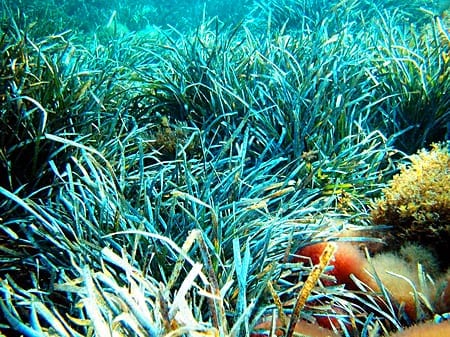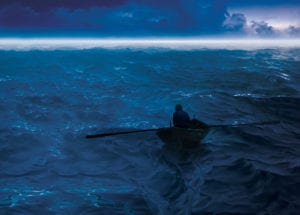By Daniel de la Calle
•Monterey Bay Aquarium Research Institute scientists have launched a sophisticated, unique tool to study the effects of Ocean Acidification on deep-sea animals in their native habitat, using free-flowing water. The idea behind Free-Ocean Carbon Enrichment (FOCE) is to create a test area on the seafloor where seawater pH can be controlled. Small animals can be placed in the test chamber and their behavior and physiological responses monitored.

Photo by MBARI
Read more about the fascinating experiment HERE.
•Two papers recently published in Global Change Biology by scientists from Australia, the US and France provide an interesting look at how the threat of Ocean Acidification to reefs vary from one to another.
“Overall, CO2 enrichment and ocean acidification is bad news for coral reefs”, says Dr. Ken Anthony, Research Team Leader for the Climate Change and Ocean Acidification team at the Australian Institute of Marine Science. “But some reef areas take up more CO2 than they produce (through photosynthesis), which can lower the vulnerability of neighboring reef areas to ocean acidification. On the other hand, reef areas with greater coral cover produce more CO2 than they consume (through calcification and respiration) and that adds locally to the ocean acidification threat”. Dr Joanie Kleypas of the National Center for Atmospheric Research believes that “If we can start to understand which areas of large reef systems such as the Great Barrier Reef can counteract pH changes locally and which areas cannot, then we are better able to assess the relative risks of ocean acidification”.
“Reef managers have been faced with the problem of ocean acidification as a uniform threat affecting all reef areas equally. These new studies are a first step to help reef managers understand how some areas might in fact lower the impact of ocean acidification in neighboring areas, whereas others will further acidify themselves. Seagrass beds, for example, can significantly reduce CO2 levels in the water, providing more favorable chemical conditions for neighboring reefs”, says Dr Anthony. Continue reading HERE.
•I recently saw an advertising piece about the use of biodegradable bags and plastic wrappings on sailing boats. Sailors around the world should embrace the idea and commit to only using compostable and biodegradable bags, leading an example and modestly fighting the alarming presence of plastics in the oceans. The particular brand is called BioBag, and HERE is the page where you can read more about the benefits of using such products.
•Ken Caldeira continues his series of videos about Ocean Acidification and coral reefs for the Carnegie Institution for Science on Youtube. This one is with Julia Pongratz:
•David Shiffman, a PhD Student and research assistant at the RJ Dunlap Marine Conservation Program asked for our vote in the 2011 Blogging Scholarship (which provides $10,000 towards education and research expenses) finals. I already voted for him and his shark conservation blog HERE. If you want to vote too just remember that it is the bubble next to “David Shiffman: Southern Fried Science”.
•Two or three blog posts ago I wrote about insular dwarfism and this week I have some news about animals diminishing in size: recent studies indicate that climate change might be shrinking numerous plant and animal species. David Bickford, from the National University of Singapore believes ectotherms (cold-blooded animals like toads, turtles and snakes that rely on environmental heat sources) are changing a lot. The study draws information from fossil records as well as “comparative studies and research implicating anthropogenic climate change over the last hundred years”. For example, fossils from a warming phase during the Palaeocene-Eocene Thermal Maximum indicate that burrowing invertebrates like beetles, bees and ants shrank in size by up to 75%. In the seas, each degree of warming has been shown to decrease the size of fish by up to 22%, but the biggest threat to marine life could be the reduced growth rates of phytoplankton in response to acidification, which “could negatively affect all ocean life because it forms the basis of the marine food web”, says Bickford.
You can read more in THIS CNN piece.
•Researchers in Spain are using posidonia oceanica seagrass meadows to track the evolution of heavy metal pollution in Mediterranean waters all the way back to 4,500 years ago.

Photo by Alberto Romero
The first heavy metal residue is found in the strata going 2,800 years back, coinciding with the first mining and metal work by Romans and Greeks. During the last 1,200 years the presence of metals has increased gradually, but it was within the last 350, since the beginning of the industrial revolution, that the levels began to skyrocket, with a significant increase in the presence of lead, zinc and arsenic. These threatened seagrass beds can be invaluable to research, but they more importantly serve as a great filter and storer of heavy metals along the Mediterranean shoreline.
As a footnote, the posidonia meadows around the coast of the island of Ibiza are over 5 miles long and are believed by some to be the biggest and eldest living organism, continually growing for over 100,000 years.
Read about it (in Spanish) HERE.
•A new study by a group of European scientists led by Michael T. Burrows, from the Scottish Marine Institute, reveals that, although ocean temperatures are increasing at a slower rate than in the atmosphere, its progress and effects on sea life is quite similar. Spring keeps coming two days earlier every year and regional temperatures are traveling North and South from the equator at an average speed of 27 kilometers per decade. Also, the rate of warming seen by the scientists was greatest in equatorial oceans, which is also where biodiversity is currently highest, the analysis shows.
Species are having to either migrate to keep living within the same temperatures or, in some cases, modify their reproductive times. But these options are not available for all animals. Arctic species cannot migrate to colder regions and in places like the Mediterranean, where the sea is enclosed between Europe and Africa, a migration North is not possible. Carlos Duarte, research scientist for the Consejo Superior de Investivaciones Científicas in Spain concludes: “when the speed of climate change is faster than the speed organisms can disperse or when there are physical barriers that make dispersion impossible species can only adapt or become extinct.” The ARTICLE in the online edition of El País. The information published in the journal SCIENCE IS HERE.


